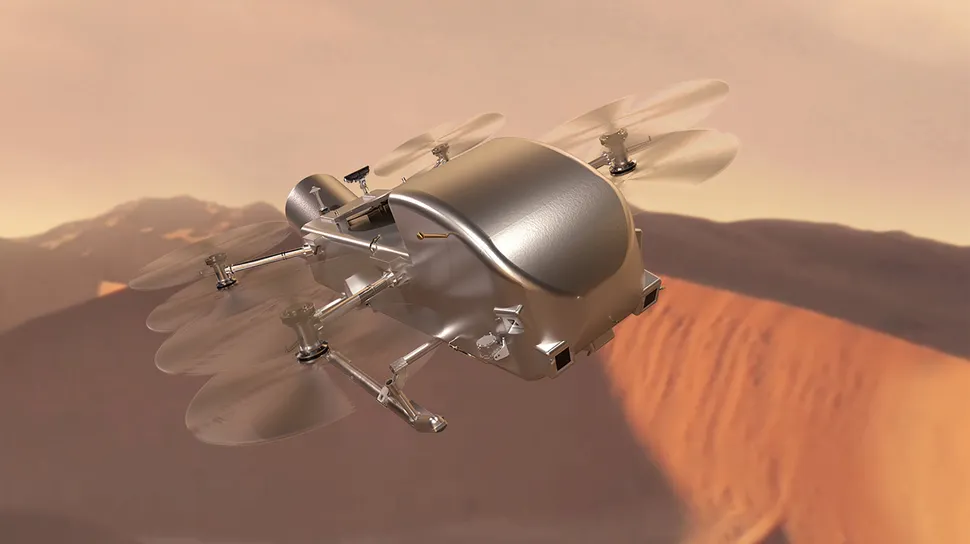NASA has set a provisional launch date of July 2028 for its Dragonfly mission, meant to explore Saturn’s largest moon Titan, with budgetary uncertainty cited as the reason for the project’s one-year delay.
The Dragonfly team can now move forward with the next stage of development — Phase C — for the car-sized, nuclear-powered rotorcraft drone that will fly above and land on the sands of Titan, a world planetary scientists believe is rich in organic molecules.
“The Dragonfly team has successfully overcome a number of technical and programmatic challenges in this daring endeavor to gather new science on Titan,” NASA Science Mission Directorate associate administrator Nicola Fox said in a statement. “I am proud of this team and their ability to keep all aspects of the mission moving.”
At NASA’s Outer Planets Assessment Group (OPAG) meeting on Nov. 28, the director of the agency’s planetary science division, Lori Glaze, revealed the reason for the launch delay — originally set to head to Titan in 2027. She said that formal confirmation of Dragonfly and the official costing and scheduling of the mission by NASA’s Agency Program Management Council (APMC) had been postponed due to uncertainty about how much money would be available for the project.
“Because of these incredibly large uncertainties in Financial Year 2024 and Financial Year 2025 funding and budgets, the decision was made at the APMC to postpone the official confirmation,” Glaze said at the meeting.
She added that Dragonfly would be taken back to the APMC in spring 2024 after NASA’s Financial Year 2025 budget proposal.
The team will replan the mission upon request, and when any necessary restructuring has been completed and reviewed, NASA will officially assess the mission’s launch readiness date in mid-2024. This means some elements of Dragonfly’s final mission design and fabrication will be delayed while others proceed.
Thus far, Dragonfly is the only NASA mission scheduled to visit the surface of an ocean moon. Once at Titan, the drone will search for conditions that could imply habitability. Dragonfly will also investigate how far any possible prebiotic chemistry has progressed on the moon of Saturn and even hunt for signs of water or hydrocarbon-based life that already exist there.
In addition to traveling further across an alien world than any other planetary rover has, the 4 dual-bladed rotorcraft will also land on Saturn’s surface in different regions, collecting samples to determine the composition of surface materials under varying geological conditions.
The investigation of Titan is of high priority for planetary scientists because, in addition to being an ocean world, it is the only solar system moon known to possess a thick atmosphere and an Earth-like hydrological cycle of methane clouds, rain and liquid flowing across its surface and filling lakes and seas. This, and the potential presence of abundant complex organic materials frozen into the moon‘s icy surface, boosts the potential for habitability on Titan.
Dragonfly, which will be built and operated by Johns Hopkins Applied Physics Laboratory (APL) in Laurel, Maryland, is constructed to conduct this investigation using its equipped cameras, sensors and samplers.
“Dragonfly is such a daring endeavor, like nothing that has ever been done before,” Dragonfly principal investigator Elizabeth Turtle said. “I’m inspired by the way our team has repeatedly overcome challenges by working together and thinking outside the box.”
Several Dragonfly components, including its control and navigation systems, have already been tested over the deserts of California — chosen for its resemblance to the sand dunes of Titan — as well as in wind tunnels at NASA’s Langley Research Center. A full-scale model has also been tested in Johns Hopkins APL’s massive Titan Chamber — which simulates the frigid temperatures and atmospheric pressures of Titan’s methane-rich environment.
“We’ve demonstrated that we’re ready for the next steps on the path to Titan, and we’ll keep moving forward with the same curiosity and creativity that have brought Dragonfly to this point,” Turtle concluded.
Credit: Space.com



